Easily Fix Spraddle Leg/Splayed Legs with a Drinking Glass
Spraddle leg/splayed legs are a common problem in chicks that can be easily cured if caught early. Learn how I do it with a drinking glass.
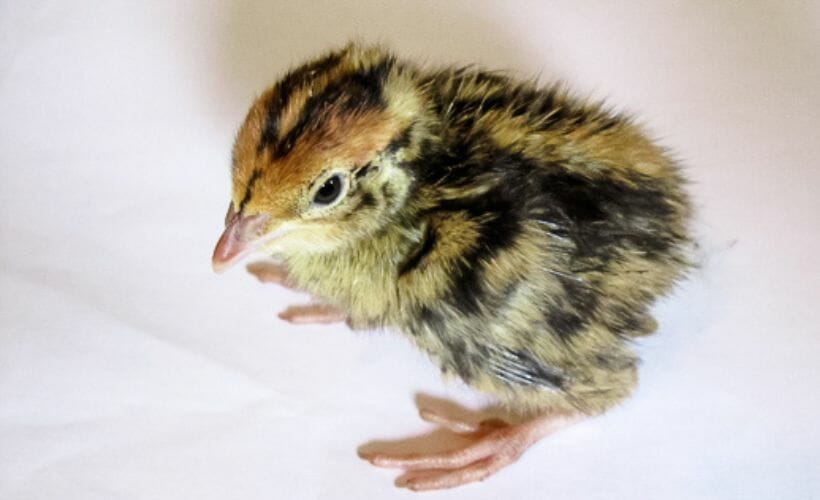
Today, I will share an inventive and effective solution for treating spraddle leg or splay leg in chicks. In addition to discussing the treatment method for spraddle leg, I will also delve into the prevention of splayed legs during incubation and brooding, as well as touch upon the related issue of curled toes in baby chicks. With valuable insights on preventive measures, traditional treatments, and more, you’ll gain a comprehensive understanding of how to support your chicks’ leg health from the early stages of their lives.
What is Spraddle or Splay Leg?
Spraddle leg, also called splay leg, is a condition where a newly hatched chick’s legs “splay” out to the sides. One or both legs may be affected. Often, it occurs from brooding chicks on a slippery surface such as a newspaper. Other causes include incubator temperature issues (if a large number of chicks are affected at hatch, this is most likely the cause), vitamin deficiency, or being in a poor position in the egg. All poultry are at risk for spraddle leg.
What is the Cause of Spraddle Leg?
A weakness or injury in the tendons of the feet and legs causes splay leg/spraddle leg. The most common cause is a brooder floor that is too slippery, and the baby chick’s legs slip, causing tendon injury in the legs. It could be caused by incubation issues as well. Read on!
Preventing Splayed Legs in the Incubator
We talk a lot about traction when it comes to preventing spraddle leg, but heat is the biggest thing when it comes to preventing the condition while the chick is in the brooder. Chicks that are exposed to elevated incubation temperatures may have lower muscular strength to stand up when they hatch. Overheated chicks that hatch will be lethargic and may appear exhausted, slow to search for feed and water, and potentially become starved within the first week of life.
Make sure you are incubating at the proper temperatures for the eggs you’re hatching. First, be sure your temperature and humidity gauges are accurate. I have a digital Brinsea Hovabator, but I also use an IncuTherm Plus Digital Thermometer/Hygrometer to compare. Second, make sure your incubator has maintained a steady temperature for at least 48 hours before setting your eggs.
Traction in the incubator is also a concern, so when I remove the egg turner at lockdown, I also put some Gorilla Grip Drawer and Shelf Liner on the incubator tray. It gives the chicks traction when they’re running about, and it also seems to keep eggs from getting knocked all around by the early hatchers.
Preventing Splayed Legs in the Brooder
I am a huge advocate of brooding chicks and other poultry on sand bedding. It is easy to clean, provides traction, stays dry, and absorbs heat from our brooder heater so the chicks can stay warm more easily.
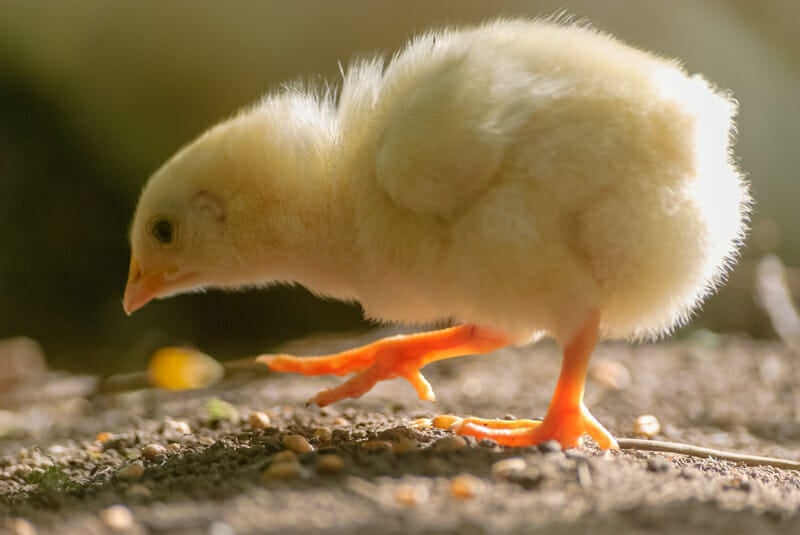
Because sand can cause impaction in tiny chicks, it is wise to wait for two or three days after hatching before using it. I lay paper towels over it for the first few days. Once it seems like the chicks have figured things out, I’ll remove the paper towels. This will give the chicks time to figure out what and where food is.
Brooder flooring to avoid includes newspaper and cardboard. Both of these provide a slick surface that frequently leads to leg injuries of all sorts.
How is Spraddle Leg Traditionally Treated?
If you search for solutions to spraddle legs on poultry forums, you will see suggestions for securing the legs in place using bandaids, medical tape, rubber bands, or string. Chicken Chick likes to use VetRap for easy application and removal. The idea is to brace the legs to strengthen them in the proper position. Spraddle leg can usually be fixed with no long-term effects as long as it’s dealt with early.
How to Treat Spraddle Leg/Splayed Legs in Chicks with a Drinking Glass
We just wrapped up a hatch of quail. These little dudes are about the size of a half dollar when they break free of their eggs. The hatch occurred over the course of three days, with the last one coming almost a full 24 hours after everyone else. This last one was having a lot of trouble finding its feet and frequently tipped over onto its back or side. It had most likely outgrown the eggshell since quail grow at such an astounding rate.
Since it was so tiny, using traditional methods for splayed legs wouldn’t work. Trying to attach anything to legs the size of toothpicks would have resulted in more harm than good.
Set Up Your Drinking Glass
Instead, I pulled out a pint glass from the dry bar. This trick I’m about to tell you about will work with all young poultry, but you will have to tailor your drinking glass to the size of your bird.
First, stuff some paper towels in the very bottom of the glass so it looks like a nest. Then, place your chick with splayed legs inside the glass. Enjoy an hour-long TV show (I watched Stranger Things) while your chick does its Physical Therapy. The chick is nestled into a standing position by the sides of the glass and the paper towel.
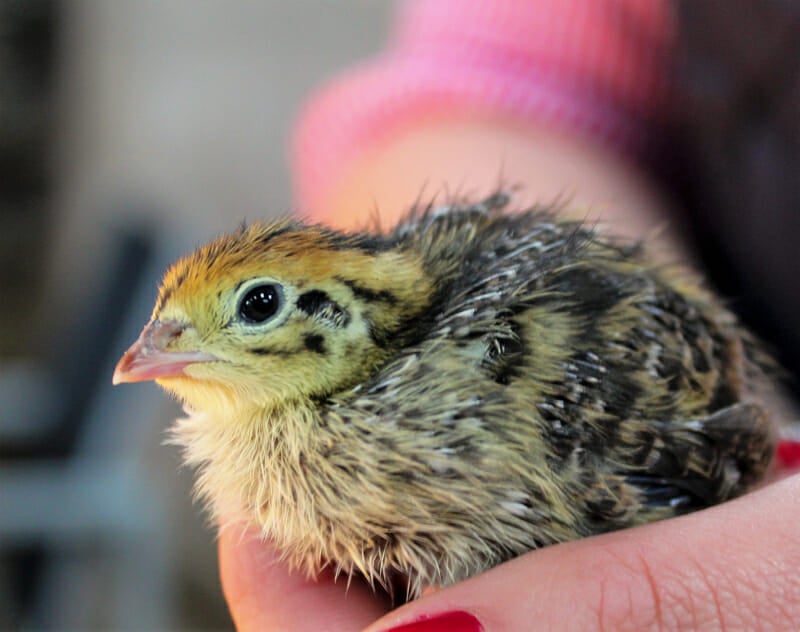
Obviously, the chick will want to pop out of the glass, so it will push and push with its legs to get over the edge. This strengthens the legs while they are in the proper position.
How Long Does Chick Therapy Take
In severe cases, repairing the damage may take a few “drinking glass physical therapy” sessions. For our little quail chick, one session was all it took. The chick was separated from the other quail for the night because she was smaller and still balancing on her hocks. The next day, she was ready to join the group. The only indicator now as to which quail chick it was is that the affected chick is smaller than the others.
How Long Does it Take to Treat Spraddle Leg?
If you’ve chosen the bracing method, remove the brace and check your chick’s progress once or twice daily. You should see results in one or two days. It shouldn’t take more than a week for the bones to harden in the proper position.
If you’ve chosen the drinking glass method, do two or three sessions a day, and you should see improvement immediately.
If your chick’s legs aren’t improving yet, you’ll want to read when it’s too late to fix spraddle leg in chicks to know when to stop treatment and what to expect.
Additional Care for Chicks with Splayed Legs
Make sure you are paying close attention to any chicks affected by spraddle legs. Keeping them separate from other chicks may be necessary so they do not get trampled or picked on. It also helps in monitoring their food and water intake. Chicks with splayed legs often cannot access water and food independently and risk drowning in water.
Although chicks can survive without food for the first few days of life, water is essential in their recovery and overall health. Electrolytes should be added to the water of any chick that is having a rough time after being moved from the incubator. Your chick(s) may also benefit from Nutri-Drench, a natural high-energy source containing vitamins, minerals, amino acids, and glucose. If you incubate your own chicks or order day-old chicks online, it’s wise to have electrolytes and Nutri-Drench in your arsenal, just in case.
Curled Toes in Baby Chicks: Prevention and Treatment
While ducks don’t really have “toes,” I want to make note that what follows applies to ducklings as well. In fact, curled “toes” seem to be more common in ducklings than any other type of poultry.
Preventing Curled Toes
Curled toes happen much the same way that splayed legs do. If it’s happening at the hatch or directly after, it was probably caused by a genetic issue, incorrect incubation temperatures/humidity, or a difficult hatch.
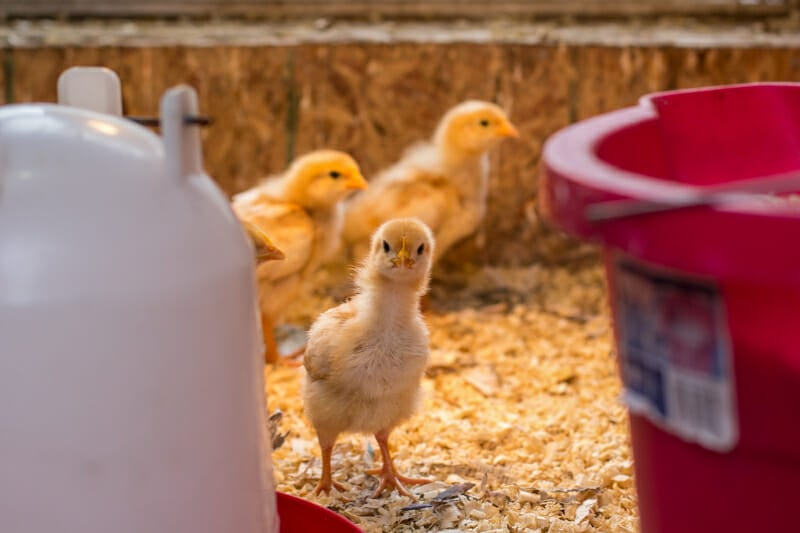
There’s not much you can do about genetic issues beyond making sure you’re incubating eggs from healthy hens. To give the best odds, make sure you have your temperature and humidity well calibrated before setting your eggs, and make sure your tray isn’t slippery — I like to use Gorilla Grip Drawer and Shelf Liner.
If curled toes appear after hatching and when the chick is in the brooder, it’s most likely a nutritional or management issue. Make sure that your brooder is properly sized for the number of chicks you are brooding and that the surface is not slick — we use sand and top it with paper towels for the first couple of days. Also, make sure that you are feeding the proper feed for your chick species. Chicks, keets, ducklings, and poults all have different nutritional requirements.
Treatment of Curled Toes
The best treatment for curled toes is tiny little bracing sandals for those little feet. Because these “shoes” (usually made with bandaids) will slow your chick down, they need to be separated from the other chicks during treatment.
Frequently Asked Questions
If you’re hatching a fair amount or regularly bringing home day-old chicks, you’ll likely come across splayed legs or curled toes. Thankfully, you’re now equipped to deal with it.
For more hatching information, check out Lockdown & Brooder Setup, Hatch Day: Hatching Process & Losses, How to Get a 60% Hatch Rate with Duck Eggs, and How to Incubate and Brood Coturnix Quail.
If you’ve found value in this blog post and enjoyed reading it, why not share it with your Pinterest community? Pin the image below and spread the love!
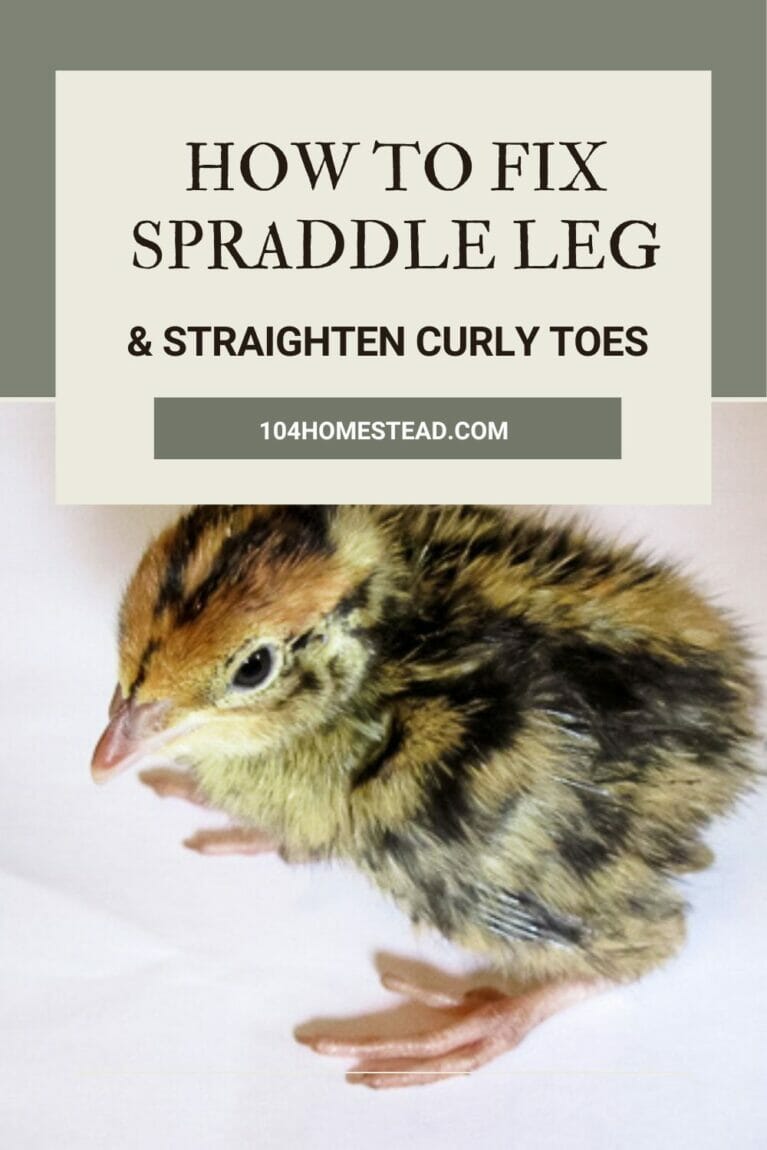
Recognizing and addressing spraddle leg or splay leg in chicks is crucial for their overall health and well-being. Using a drinking glass as a creative treatment method, coupled with proper incubation and brooding practices, you can effectively tackle these leg conditions and set your chicks on the path to a strong and active life. Early intervention and proactive care are key to nurturing healthy and thriving poultry.
Have you ever encountered spraddle leg or curled toes in your chicks? I would love to hear your experiences and insights in the comments below!

I tried it with a Corturnix quail chick and it worked! My glasses were too wide so I used a shot glass, which was too short, and then I put the shot glass inside another larger glass. I put the chick in over night and then for some shorter repeated sessions for a couple days. Worked great! Thank you!
Sorry I can’t get the photos to upload. It’s such a cute pic!
Hi,
So what’ve ya’ got for an older duck in the same boat? She’ll be 11 on the 8th of next month. She started off lame on 1 leg, 2 different vets couldn’t figure out why (a few years back, at that) & of late has become almost full blown splayed (she could stand to lose an ounce or 3, both of the aforementioned vets each exclaimed, “That’s the biggest duck I’ve ever seen!” the first time they each saw her). She can stand here & there, does better off outside than in. She gets lots of pool time this time of year, although she paddles a bit differently now than she used to. Got any pearls of wisdom that may help her out? Thank you! 😀
Thank you for this information.
How do you feed your chick manually if it’s not feeding / drinking by itself?
Thank you.
Hi, I’m having an issue with my chick that isn’t eating or drinking on its own either. I have to dip it’s beak into water and then it drinks. It still isn’t eating. Did you get anywhere with your chick that wasn’t eating and have any advice you could pass on to me? Thanks!!
This is a brilliant idea. I didnt have any appropriate glassware so I used varying sizes of coffee mugs. It massively helped my chick even though I built him a splint too. It reaally forced them to do their own rehab but keeps them from faaling over constantly. I’m made some videos and will post them later on the youtube channel. Search for steve ducks.
Yes great idea somehow I thought of it myself before even reading this post my silky chick was so smalle that I actually Came up the idea of putting him in the inside of a toilet paper roll and that worked like a charm it was balanced due to being inside of a narrow cup.
Thank you for this post. We’ve got a little quail chick on its second treatment, having been much improved after the first. The poor little thing had been hopping around since hatching four days ago, but in the glass last night it scratched its head for the first time! Think it’s problems were caused by three hatch mates pecking it out of the egg in excitement, very weird to see.
Very Helpful, for new chick unable to stand. TYSM! Had tried bandaids before with marginal success.
Excellent advice! I usually use tape as for some reason eggs mailed to me always seem to have a few with leg problems. I read about this method before but wanted to check I was doing it right and you came up on my search. Only put them in the glass for 20 min and then separated them into a box with an old face cloth. Between the nonslip cloth and glass, the two are walking much better. Will give them more time in the glass to make sure in a few hours. This time a full hour in there.
I’m so glad to hear that’s working for you!
Hello I have two turkey chicks from my neighbor that one of her hens hatched one has a splayed leg I tried the band aide method seemed to work at first but it didnt work ood so i separated it from the other healthy one put him in a small basket to restrict his wobbling and falling plus being stepped on. Any ideas how to feed him or for him to access food Im afraid to leave water in there for him to drown. Thank you for any ideas
Tried this with a button quail and made it much worse. Chick pushed against instead of trying to jump out. Came out in much worse condition, but After almost a day taped it with bandage tape. I think it may be ok. I’m not saying this technique doesn’t work; maybe not for button quail. It was so small I used a pill bottle, everything else was to wide.
The drinking glass technique works!! Our week old Pekin duckling was too big for a pint glass so we used a 32 oz thermal cup. 2 days of physical therapy and she is walking, swimming, and interacting with her siblings. Hobbling did not work as she would just lay down and not walk. Thank you so much for this advice!!
Maybe this is a silly question, but this was my first hatch that was incubated instead of with a broody. I’ve got one Pavlovskaya with spraddle and he/she is 3 days old. My question is, if I do this awesome glass method overnight like you say, does chickie need a heat lamp? Clearly a drinking glass with chick won’t fit under my heating element in brooder. Thanks!
I’m just wondering if you had a photo of this method? I’ve had 6 baby quail hatch overnight and 4 have splayed legs. I’ve taped them as per other youtube suggestions but this may ba a better solution.
Hello…..we have a week old chick that has spraddle leg in both legs. We braced them up with vet tape but he has no desire to stand. He lays and eat and drinks. I try to lift him up, but he won’t try to lift himself. If I try to use the glass, do I keep the brace on? Thank you.
II have a baby Lovebird 5 weeks old just given to me that’s splayed legged and also chooses to just lie down rather than try and stand .
Hi there, I’m a lot late to this so I’m not sure if my situation can be helped. I was given a 10 month old Coturnix Quail and he has a splayed leg. He is eating and drinking fine, but he is only able to lay on his side. He gets around by his wings and uses his feet to kick himself around but he can not stand. He also has some diarrhea going on. So maybe I have two problems going on. He has actually come a long way since I got him as before he was rather listless and not getting around much. I wanted to at least give the little fellow a chance and he certainly has perked up in the week and a half since I’ve had him. But I would like to see him be able to walk if there is any chance of it.
Any suggestions?
Thanks!
Thank you so much for the post I made an incubator and put four quail eggs in all but one came out with spraddle legs. This post was a life saver.iknow some say the best thing is to put them down but if there is a chance, why not try it. I was upset and stressed before I found this post .But after only one therapy session I found a big improvement.
Thanks again and keep sharing.
Hey! I’m a little late to the party but I just wanted to say you are a LIFE SAVER! Literally. Yesterday we acquired three bantam chicks (FREE) from our feed supply because the lady said they would most likely die there, so why don’t we take them and give them a chance? Last night we worked with the worst of the three and it actually was pretty happy in its glass. We saw definite improvement and today she’s walking better! Thank you for saving our banties!
Ah Thank you. Today I saved a quail thanks to your post. It hatched today and could not walk due to curled toes and legs sticking to the sides. I taped the feet with bandages for a few ours and they looked better but legs still to the side, then an hour in cup and is now walking and eating. I also put some shelf liner so that it could get more traction. Cheers!
Laura
I wish I read this a few months ago. I used surgical tape, it worked, but it was a nightmare to put and remove the bandage. So do you use a champagne glass? Like the skinny ones?
I use a beer glass, but anything that is fairly narrow with a slightly rounded bottom will work. Just make sure it’s not so narrow that you can’t get the chick out 😉
Would sure love some video on this!
I’m hoping we don’t have another occurrence any time soon, but if we do, I’ll be sure to record it and add it here. We are done with quail for this year and it doesn’t often happen with our chicken chicks.
Had a pheasant chick this morning with SEVERE spraddle leg. Looked like she was rowing a boat rather than walking! Seriously! So into a glass she went with paper towel footing. Left her for 2 hours there in brooder not too close to the heat. After two hours, no spraddle, walking normally. Two hours after that, walking like all the other chicks (I knew which one she was because I marked her with marking pen, otherwise I couldn’t has found her!). I’ve tried tying legs, it just is too difficult. I often put them back in with the eggs for a while, that helps, but this is far better and in such a short time. Thank you so very much for posting this treatment!!! I took picture of her in glass but can’t seem to attach.
I’m so glad to hear that!
Wish there was a picture of the chick in the glass
Dear Jessica we are living in the middle of no where southern france, a neighbour gave me about 10 chicks with one hen as so many of her hens were treacherous this year and hid out til their eggs hatched…anyway to cut a long story short one little one has this dilemma and I thought it was just that…good circulation but tape did not work and after a while just left it, named him Mephibosheth. Now I will try your physio with it and hope its not too late and set.
Thank you.
I’m not sure how old it is, but there is still hope. It may take more “sessions” before you see results. If the chick is able to get around, it may still be okay, even if it’s not repaired. A friend of mine rescued two chickens with legs lost to frostbite. They get around using their wings. It’s actually quite impressive.
we have a 2-week old guinea chick. She developed this a few days after birth. So do you think this trick will still work?
The sooner the better, but there is still hope. Obviously, you’ll need a larger glass. You want it to hold the chick upright, but not squish it. I have a feeling you will need to do it a few times since the chick is older.
This is a great solution to a very common problem. You’re a genius! What a cute quail chick. Your kids must be over the top with excitement.
They are head over heels in love. They named the one gold one because it’s the only one you can pick out of the mob.
This is great, I don’t have chickens yet, but I will be referring to this when I do get them. Pinned for later.
Thanks for sharing.
Thanks!
I’ve tried this three times with my two new guinea keets, and they fall asleep in the glass. Neither keet wants to walk on their feet, only on their knees. I’ve tried a pint glass and a seven ounce glass.
Am I doing this wrong?